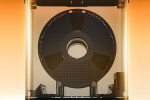New Sunlu FilaDryer SP2: Technical specifications and pricing
Chinese 3D printing technology firm SUNLU has released a new filament drying system designed to offer more flexibility for 3D printing users managing multiple spools.
Called the FilaDryer SP2, the unit separates its heating base from the drying chambers, allowing up to three chambers to be stacked vertically. This setup is aimed at users running several printers at once, where space is limited and filament drying often becomes a bottleneck.
Founded in 2013 in Zhuhai, China, SUNLU specializes in 3D printing materials and hardware, with a product range that includes filaments, resins, and accessories. Having sold more than 25 million units, the company runs over 140 production lines and holds over 200 granted IP rights related to materials and equipment design.
FilaDryer SP2 Capacity. Image via Sunlu.
Scalable design with efficient drying
One of the key goals behind the SP2 is to improve drying efficiency. In repeated tests with PETG, the system brought moisture levels down from 0.6% to 0.2% in just four hours. That’s around 30% faster than other dryers in the same category. The adjustable temperature range, which runs from 35°C to 70°C, makes it suitable for common materials like PLA as well as moisture-sensitive filaments such as nylon.
Each chamber includes a built-in humidity sensor for real-time monitoring and offers enough space to hold either two 1kg spools, a single 2–3kg spool, or spools measuring up to 250 mm in diameter and 153 mm in width. The generous capacity is especially useful during long print jobs, where smaller dryers often fall short. In one example, saturated PLA reached optimal moisture levels within four to six hours at 55°C, demonstrating the system’s effectiveness for extended use cases.
Safety features are built into the SP2’s design. It uses a ceramic PTC heater combined with a smart fan to ensure heat is evenly distributed. A mechanical cutoff switch activates if temperatures spike unexpectedly, while a PID-controlled microprocessor keeps the system stable within a one-degree range.
The device has passed 72-hour continuous operation tests and was also run through high-stress scenarios to confirm reliability. Additional silicone gaskets at connection points help keep moisture out and maintain consistent drying conditions.
Compared to conventional dryers, which are typically fixed in design and limited to a single chamber, the SP2 offers a more scalable solution. Instead of purchasing an entirely new unit, users can expand capacity by adding additional chambers. It also accommodates smaller spools without the need for adapters or modifications.
Additionally, internal testing indicates up to 35% lower energy consumption than similar products. In early use, the system has also been noted for its quiet operation at 42dB, stable stacking, and consistent temperature control across extended sessions.
Dry and store filaments with built-in heating and humidity control. Image via Sunlu.
Technical specifications and pricing
For pricing details and more information, readers can visit Sunlu’s website.
Product NameSUNLU Filament Dryer SP2 / Storage Box SetProduct Dimension278mm × 208mm × 396mmInternal Dimensions265mm × 193mm × 274mmPackage Size337mm × 263mm × 380mmN.W.FilaDryer SP2 Set: 3.6KG, Storage Box Set: 5.0KGG.W.FilaDryer SP2 Set: 4.1KG, Storage Box Set: 5.5KGOperating EnvironmentTemperature: 10°C-35°C, Relative Humidity: ≤95%Compatible Filament DiametersΦ1.75mm/Φ2.85mmMaximum Spool SizeΦ250mm × 153mmWork Temperature Range35°C-70°CHumidity Display RangeRefer to the Hygrometer: 10%-90%Time Setting Range0-99hPower Input SpecificationsAC 110V 60Hz 0r AC 220V 50HzMaximum Operating Current2.2A@230V, 4.2A@120VMaximum Working Power250wStand by Power≤1WPackage Contents: FilaDryer SP2 SetStorage Box *1, Heating Base *1, Hygrometer *1, Desiccant *1, Desiccant Box *1, Power Cable *1, Spool Roller *1, Air lock *2, PTFE Tube 8cm *2, PTFE Tube 1m *2, User Manual *1Storage Box SetStorage Box *1, PLA+2.0 Black *2, Hygrometer *1, Desiccant *1, Desiccant Box *1, Spool Roller *1, Air lock *2, PTFE Tube 8cm *2, PTFE Tube 1m *2, User Manual *1
Take the 3DPI Reader Survey — shape the future of AM reporting in under 5 minutes.
What 3D printing trends should you watch out for in 2025?
How is the future of 3D printing shaping up?
To stay up to date with the latest 3D printing news, don’t forget to subscribe to the 3D Printing Industry newsletter or follow us on Twitter, or like our page on Facebook.
While you’re here, why not subscribe to our Youtube channel? Featuring discussion, debriefs, video shorts, and webinar replays.
Featured image shows the Sunlu FilaDryer SP2. Image via Sunlu.
Ada Shaikhnag
With a background in journalism, Ada has a keen interest in frontier technology and its application in the wider world. Ada reports on aspects of 3D printing ranging from aerospace and automotive to medical and dental.
#new #sunlu #filadryer #sp2 #technical
New Sunlu FilaDryer SP2: Technical specifications and pricing
Chinese 3D printing technology firm SUNLU has released a new filament drying system designed to offer more flexibility for 3D printing users managing multiple spools.
Called the FilaDryer SP2, the unit separates its heating base from the drying chambers, allowing up to three chambers to be stacked vertically. This setup is aimed at users running several printers at once, where space is limited and filament drying often becomes a bottleneck.
Founded in 2013 in Zhuhai, China, SUNLU specializes in 3D printing materials and hardware, with a product range that includes filaments, resins, and accessories. Having sold more than 25 million units, the company runs over 140 production lines and holds over 200 granted IP rights related to materials and equipment design.
FilaDryer SP2 Capacity. Image via Sunlu.
Scalable design with efficient drying
One of the key goals behind the SP2 is to improve drying efficiency. In repeated tests with PETG, the system brought moisture levels down from 0.6% to 0.2% in just four hours. That’s around 30% faster than other dryers in the same category. The adjustable temperature range, which runs from 35°C to 70°C, makes it suitable for common materials like PLA as well as moisture-sensitive filaments such as nylon.
Each chamber includes a built-in humidity sensor for real-time monitoring and offers enough space to hold either two 1kg spools, a single 2–3kg spool, or spools measuring up to 250 mm in diameter and 153 mm in width. The generous capacity is especially useful during long print jobs, where smaller dryers often fall short. In one example, saturated PLA reached optimal moisture levels within four to six hours at 55°C, demonstrating the system’s effectiveness for extended use cases.
Safety features are built into the SP2’s design. It uses a ceramic PTC heater combined with a smart fan to ensure heat is evenly distributed. A mechanical cutoff switch activates if temperatures spike unexpectedly, while a PID-controlled microprocessor keeps the system stable within a one-degree range.
The device has passed 72-hour continuous operation tests and was also run through high-stress scenarios to confirm reliability. Additional silicone gaskets at connection points help keep moisture out and maintain consistent drying conditions.
Compared to conventional dryers, which are typically fixed in design and limited to a single chamber, the SP2 offers a more scalable solution. Instead of purchasing an entirely new unit, users can expand capacity by adding additional chambers. It also accommodates smaller spools without the need for adapters or modifications.
Additionally, internal testing indicates up to 35% lower energy consumption than similar products. In early use, the system has also been noted for its quiet operation at 42dB, stable stacking, and consistent temperature control across extended sessions.
Dry and store filaments with built-in heating and humidity control. Image via Sunlu.
Technical specifications and pricing
For pricing details and more information, readers can visit Sunlu’s website.
Product NameSUNLU Filament Dryer SP2 / Storage Box SetProduct Dimension278mm × 208mm × 396mmInternal Dimensions265mm × 193mm × 274mmPackage Size337mm × 263mm × 380mmN.W.FilaDryer SP2 Set: 3.6KG, Storage Box Set: 5.0KGG.W.FilaDryer SP2 Set: 4.1KG, Storage Box Set: 5.5KGOperating EnvironmentTemperature: 10°C-35°C, Relative Humidity: ≤95%Compatible Filament DiametersΦ1.75mm/Φ2.85mmMaximum Spool SizeΦ250mm × 153mmWork Temperature Range35°C-70°CHumidity Display RangeRefer to the Hygrometer: 10%-90%Time Setting Range0-99hPower Input SpecificationsAC 110V 60Hz 0r AC 220V 50HzMaximum Operating Current2.2A@230V, 4.2A@120VMaximum Working Power250wStand by Power≤1WPackage Contents: FilaDryer SP2 SetStorage Box *1, Heating Base *1, Hygrometer *1, Desiccant *1, Desiccant Box *1, Power Cable *1, Spool Roller *1, Air lock *2, PTFE Tube 8cm *2, PTFE Tube 1m *2, User Manual *1Storage Box SetStorage Box *1, PLA+2.0 Black *2, Hygrometer *1, Desiccant *1, Desiccant Box *1, Spool Roller *1, Air lock *2, PTFE Tube 8cm *2, PTFE Tube 1m *2, User Manual *1
Take the 3DPI Reader Survey — shape the future of AM reporting in under 5 minutes.
What 3D printing trends should you watch out for in 2025?
How is the future of 3D printing shaping up?
To stay up to date with the latest 3D printing news, don’t forget to subscribe to the 3D Printing Industry newsletter or follow us on Twitter, or like our page on Facebook.
While you’re here, why not subscribe to our Youtube channel? Featuring discussion, debriefs, video shorts, and webinar replays.
Featured image shows the Sunlu FilaDryer SP2. Image via Sunlu.
Ada Shaikhnag
With a background in journalism, Ada has a keen interest in frontier technology and its application in the wider world. Ada reports on aspects of 3D printing ranging from aerospace and automotive to medical and dental.
#new #sunlu #filadryer #sp2 #technical
0 Σχόλια
·0 Μοιράστηκε
·0 Προεπισκόπηση





